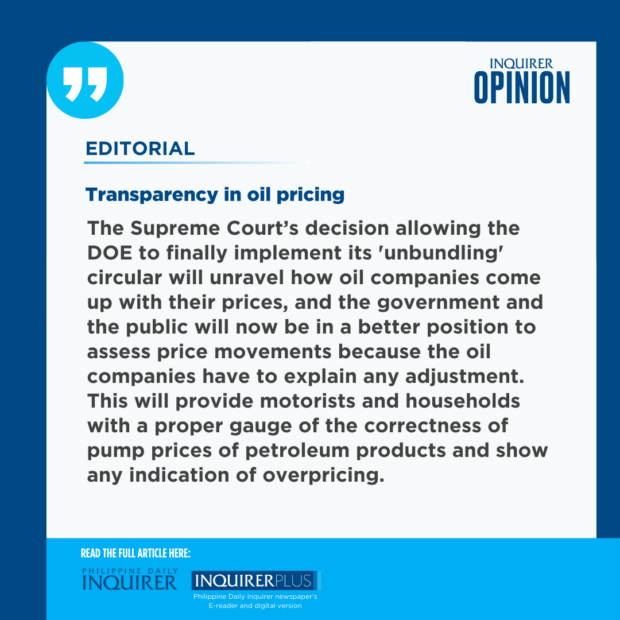
Every week, oil companies announce adjustments in their pump prices. Consumers feel relieved when prices are adjusted lower, but are left with no choice but to absorb any increase, notwithstanding the lack of any explanation from oil firms as to why they were raising their prices.
These pricing details were supposed to have been itemized in 2019 when the Department of Energy (DOE) issued Department Circular No. DC2019-05-0008, or the Revised Guidelines for the Monitoring of Prices in the Sale of Petroleum Products by the Downstream Oil Industry in the Philippines. It required oil companies to submit to the DOE’s Oil Industry Management Bureau a report containing the detailed computation with corresponding explanations and supporting documents.
Oil companies, however, opposed the DOE move because of the tedious work needed to comply. More importantly, they would have to reveal their so-called “industry take amid a deregulated environment.” In short, they did not want the public to know how much profit they make.
Price control
The oil firms immediately challenged the legality of the circular at the Makati City Regional Trial Court (RTC), claiming that it violated their rights and was contrary to Republic Act No. 8479, or the Downstream Oil Industry Deregulation Act of 1998, because some of its provisions were tantamount to price control and imposed impossible requirements on oil companies. On Aug. 14, 2019, the lower court issued a writ of preliminary injunction stopping the DOE from implementing its circular. When its motion for reconsideration was denied by the RTC, the DOE brought the issue to the Court of Appeals (CA).
On Oct. 3, 2022, the CA agreed with the DOE’s position that there was no clear right to be violated by the implementation of DC2019-05-0008 as the same did not impose any price control nor dictated market prices to influence and regulate the oil industry. The CA also noted that the alleged damage that would be suffered by the oil companies was “more imagined than real since these are bare allegations founded on an unclear source of right…” The oil companies then elevated their case to the Supreme Court.
Fair pricing and transparency
The high court’s First Division, in its ruling on G.R. No. 266310 promulgated on July 30 but made public only last week, said that “[w]hile it may indeed be difficult or tedious for oil companies, surely, there is a way for them to compute and determine the required information based on the existing data or formula available to them.”
“We find it hard to believe that the prices these oil companies release are merely made up out of the blue and without any basis at all,” the Supreme Court noted. It added that there is a systematic calculation or process on how they set their prices, and it is such information that the DOE needs to collect for it to accomplish its mandate under RA 8479, which granted the DOE the power to monitor and publish daily international crude oil prices, and to follow the movement of domestic oil prices.
The rationale for this so-called “unbundling” is to encourage fair pricing and transparency, similar to what the Manila Electric Co. has been doing with consumer’s electricity bills. It will detail petroleum prices based on its components such as landed costs, port charges, expenses for refining, storage, handling, marketing, and transshipment, as well as taxes and oil company profit margin.
Anti-competitive practices
This will then provide the DOE and other relevant government agencies with the information necessary to formulate appropriate policy initiatives for the benefit of consumers. The information provided will also support investigations of anti-competitive practices such as predatory pricing, or even smuggling.
The goal of the oil deregulation law was to bring about “a truly competitive market under a regime of fair prices.” By allowing the entry of new players to challenge the big three oil companies — Shell, Caltex, and Petron — the government was hoping that market forces would determine real oil prices. Since the 1998 deregulation, more players have indeed entered the market and expanded the industry coverage even to far-flung areas. However, consumers have noted how pricing has remained opaque, with the prices posted by oil firms for their fuel products such as gasoline, cooking gas, and diesel having differences of only a few centavos.
The weekly fuel price adjustments have remained a mystery to the DOE and consumers for a long time. The Supreme Court’s decision allowing the DOE to finally implement its “unbundling” circular will unravel how oil companies come up with their prices, and the government and the public will now be in a better position to assess price movements because the oil companies have to explain any adjustment. This will provide motorists and households with a proper gauge of the correctness of pump prices of petroleum products and show any indication of overpricing. This transparency will hopefully redound to the benefit of consumers.

